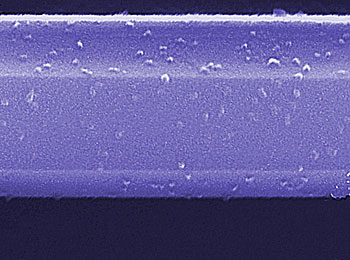At the National Institute of Standards and Technology (NIST), George Mason University and the University of Maryland a team of scientists have constructed nano-sized sensors which can detect volatile organic compounds.
 Scanning electron microscope image of a gas sensor segment fabricated of a semiconducting nanowire of gallium nitride. The nanowire of less than 500 nanometers across is coated with nanoclusters of titanium dioxide, which alters the current in the nanowire in the presence of a volatile organic compound and ultraviolet light. Image Credit: National Institute of Standards and Technology
Scanning electron microscope image of a gas sensor segment fabricated of a semiconducting nanowire of gallium nitride. The nanowire of less than 500 nanometers across is coated with nanoclusters of titanium dioxide, which alters the current in the nanowire in the presence of a volatile organic compound and ultraviolet light. Image Credit: National Institute of Standards and Technology
These organic compounds can be harmful pollutants released from paints, cleaners, pesticides and other products. The sensors offer a major jump over the current day commercial gas sensors and their ability to detect a wide range of compounds.
Modern commercial gas sensors are made of thin, conductive films of metal oxides. When a volatile organic compound interacts with it the current running through the film alters and triggers an alarm. thin-film sensors are effective but work at 200 C or higher. Also frequent heating can degrade the material making the process unreliable.
The new sensors are built with the same fabrication processes that are commonly used for silicon computer chips. The gallium nitride wires are less than 500 nanometers across and less than 10 micrometers in length. Although they are very small they have a high surface-to-volume ratio that makes them exquisitely sensitive.
Abhishek Motayed from the National Institute of Standards and Technology said that the electrical current flowing through the nano-sensors is in the micro amps range, while traditional sensors require milliamps. He added that the nanosensors also offer greater reliability and smaller size. They're so small that you can put them anywhere. Plus they use less power and energy that the current ones.